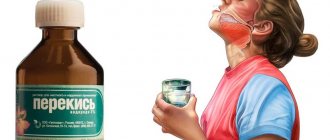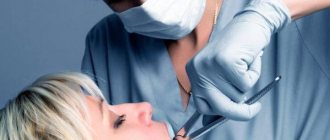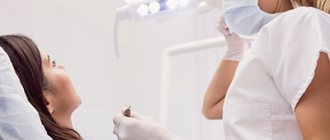What is Chlorhexidine used for?
An aqueous solution is prescribed to be taken in the following cases:
- cervical erosion;
- for the prevention of syphilis, genital herpes and other vaginal diseases;
- disinfection of dentures, disinfection of wounds;
- various diseases of the oral cavity.
An alcohol solution is used to treat hands and medical devices before surgery. The solution is also used to treat the working surface of medical equipment.
Vaginal suppositories are effective for the following conditions:
- in order to prevent infections that can be transmitted as a result of unprotected sexual intercourse;
- bacterial vaginosis;
- prevention of inflammation and infections before surgery, childbirth or abortion.
Instructions: how to take and can you rinse your mouth and throat?
Below is the answer to the question whether it is possible to use chlorhexidine to gargle or rinse your nose with this drug. Chlorhexidine is safe during gestation if used only for the following procedures:
- Baths for the oral cavity. 20 ml. the drug (0.05%) must be taken into the mouth and held for 30 - 60 seconds, after which it must be spat out and the mouth must not be rinsed. The procedure should be repeated twice a day for 7 – 10 days.
- Rinsing the mouth and throat. 1 tablespoon of a 0.05% solution of the medication is taken into the mouth, and rinsed for a minute or two. Upon completion of the procedure, it is not recommended to eat for 1 hour after rinsing. The course of treatment is 3 – 5 times a day for a week.
- Nasal rinsing. This manipulation is performed using a 0.05% drug diluted with saline in a 1:1 ratio. You need to sit comfortably and inject the medicine into each nostril so that it flows calmly out of the other nostril without getting into the throat.
The procedure should be repeated several times. Treatment regimen: 2 times a day for 7 days.Important requirement: before starting the procedure, it is necessary to clean the mouth or nose by rinsing or washing with chamomile or sage infusion.
And Chlorhexidine must be slightly warmed up by holding the container with the medication in your hands for some time: in a warm state, the drug will have the maximum beneficial effect.
How to use Chlorhexidine in gynecology
The product is actively used to prevent sexually transmitted diseases. No later than 2 hours after unprotected intercourse, you need to take the solution. Men will need to insert 2 ml into the urinary canal, and women will need to insert 2 ml into the urinary canal and another 5-7 ml into the vagina. It is recommended to wipe the skin around the genitals with the solution. The instructions say that after using the drug you need to wait 2 hours before urinating. Otherwise, the effect of use will be less.
For preventive purposes, vaginal suppositories can be used.
Before using the product for thrush and other gynecological pathologies, you should consult a specialist in advance.
Can pregnant women take it?
During pregnancy, Chlorhexidine is only suitable for external use.
Therefore, a solution for rinsing, irrigation, and washing the ENT organs becomes especially relevant during the period of bearing a child. Although the drug is considered safe for mother and child, it can only be used after consulting a doctor. Some sources indicate that such a drug can also be used for douching in pregnant women in the case of various pathologies of the genital organs. But the douching procedure itself is contraindicated during gestation or should be performed only in the manipulation room by a medical institution employee.
In case of urgent need, it can be replaced by using intravaginal Chlorhexidine suppositories or self-made tampons soaked in a solution of this drug.
In 1st trimester
Perhaps the most crucial period in pregnancy is the 1st trimester , since it is at this time that the baby and the protective placenta are formed, and all vital organs and systems are formed.
Therefore, despite the safety of the drug, it should be used only after consultation with the doctor.
In the 2nd trimester
During this period, the already formed embryo begins to develop, it is already reliably protected by the placenta, so any external influence is not so scary for it. But still, in order to avoid possible risks, it is better to consult a doctor about the advisability of using the drug.
In the later stages
The medication has no effect on the uterus and cannot provoke premature birth.
On the contrary, the drug is actively used in the prenatal period for the sanitation of the birth canal and after (for the treatment of cracks and tears in the perineum).
Contraindications and adverse reactions
Taking the drug is contraindicated in the following cases:
- increased susceptibility to the components included in the composition;
- patients with dermatitis;
- simultaneous use with other antiseptics, for example, hydrogen peroxide;
- in ophthalmology for washing the eyes.
It is better to refrain from using the product to disinfect the surgical field before or after surgery on the central nervous system and auditory canal.
In pediatrics, the drug is used with great caution.
Some patients may experience undesirable reactions such as:
- dry skin;
- allergic skin rashes;
- itching of the skin;
- light sensitivity.
With prolonged use of the product in dentistry, changes in taste may occur, tartar may appear, or teeth may become stained.
Infections caused by antibiotic-resistant microflora represent an ever-growing threat in both hospital and community settings. Nosocomial infections lead to a decrease in the effectiveness of therapy, an increase in the duration of hospitalization and an increase in mortality.
Chlorhexidine bigluconate was developed in Great Britain in 1950. It is the first internationally recognized antiseptic for skin and wounds. One of the advantages of chlorhexidine, in addition to its pronounced antimicrobial effect, is its ability to bind to various biological substrates while maintaining its antibacterial activity, and then be slowly released, which leads to the preservation of effective concentrations of the drug. To date, there are no reports of resistance to chlorhexidine, despite more than 60 years of active use of the drug in the clinic. Chlorhexidine gluconate remains important in the prevention of nosocomial infections.
Widespread use of antiseptic methods for the prevention and treatment of infections followed the publication of Joseph Lister's The Antiseptic Principle in Surgical Practice in 1867. At the same time, “Lister’s antiseptics” met ardent opponents, whose main argument was the toxicity of the antiseptic they used (carbolic acid). Despite the availability of numerous antiseptics, the question of the safety and effectiveness of this group of drugs remains constantly relevant. The “longevity” of chlorhexidine and the prospects for its further use as one of the most powerful antiseptics widely used in clinical practice is a pressing issue for clinicians.
A cationic detergent (detergent), later named chlorhexidine, was synthesized during the development of antimalarial drugs in 1947. This compound has bactericidal antimicrobial activity, especially against gram-positive microorganisms. Of the 10,040 compounds, the first to enter the market was chlorhexidine gluconate, registered in 1954 by Imperial Chemical Industries Co.LTD (UK) as “Gibitan” - the first internationally recognized antiseptic for the treatment of wound surfaces and skin. In 1957, only 3 years after entering the market, the indications for its use were expanded to include not only skin treatment, but also use in ophthalmology, urology, gynecology and otorhinolaryngology. In 1959, chlorhexidine began to be used to control bacterial plaque, leading to its widespread use in dentistry. Currently, in clinical practice, chlorhexidine is preferred not only when treating the skin (hands, surgical field), but also as an oral antiseptic, including for the prevention of nosocomial infection. The most commonly used concentrations are 0.2% and 0.12% solutions. In addition to its effect on plaque and gum condition (gingivitis), chlorhexidine is effective in the prevention and treatment of caries, secondary infections after dental procedures or implant placement. Chlorhexidine reduces the bacterial load and the risk of bacteremia after dental procedures. It is also used in the treatment of recurrent atrophic stomatitis and stomatitis associated with the installation of dentures, primarily in groups of patients with orthodontic appliances and immune disorders. One of the main advantages of chlorhexidine, in addition to its powerful antimicrobial effect, is its ability to retain its antimicrobial activity when bound to various substrates. At the same time, it is released slowly while maintaining an effective concentration. This property is known as substantiveness. Chlorhexidine is not susceptible to blood, pus, or saliva. Chlorhexidine is pharmaceutically incompatible with soap and detergents (for example, those containing lauryl sulfate), alkalis and other anionic compounds (colloids, gum arabic, carboxymethylcellulose), and iodine. Compatible with ethyl alcohol, benzalkonium chloride (contained in contraceptives for local use Pharmatex and Benatex). Ethanol enhances the effectiveness of the drug. The bactericidal effect increases with increasing temperature. At temperatures above 100°C, the drug partially decomposes. Used in a neutral environment; at pH 5-8 the difference in activity is small; at pH above 8 it precipitates. The use of hard water reduces bactericidal properties. Compatible with drugs containing a cationic group (benzalkonium chloride, cetrimonium bromide).
The unique combination of properties of chlorhexidine also determines the variety of dosage forms.
Chlorhexidine is available in the following forms: • 20% concentrated solution – intended for dilution before use, used in medical institutions; • 0.05% solution in plastic and glass bottles of 70 and 100 ml - used without dilution, including at home; • Vaginal suppositories (suppositories) “Heksikon” containing 0.016 g of chlorhexidine, 1 or 10 suppositories in a package; • Vaginal suppositories (suppositories) “Heksikon D” containing 0.008 g of chlorhexidine – intended for children, 10 suppositories per package; • Gel containing 0.5% chlorhexidine. Chlorhexidine is included in the following preparations: • Solutions for mouth rinsing for dental diseases and manipulations (tooth extraction, opening of abscesses, professional cleaning, etc.) – Elgidium, Amident, Eludril; • Gels for gums, intended for the treatment of dental diseases and pain relief in the oral cavity (for example, when getting used to dentures), one of the components of which is chlorhexidine - Dicloran Denta, Elugel, Metrohex, Parodium, Elgifluor, Dentamet, Metrogyl Denta; • Elgidium toothpaste; • Solutions with other antiseptics – Baktoderm (with benzalkonium chloride), Chlorhexidine alcohol spray – for the treatment of skin infections, Citeal (with hexamidine and chlorocresol) – for topical use in gynecology, dermatology; • Ointments Bepanten plus and Depantol (with panthenol - wound healing effect), Bemilon (with betamethasone - anti-inflammatory effect); • Vaginal suppositories Depantol (with panthenol) – used in gynecology after surgical interventions; • Chlorhexidine in combination with lidocaine for local anesthetic action in the Lidocaine-Asept spray and Instillagel and Kategel gels with lidocaine; • Lozenges for sore throat, stomatitis and other diseases of the oropharynx and oral cavity – Hexoral tabs, Anti-Angin formula, Sebidin.
pharmachologic effect
Chlorhexidine is characterized by its versatility. By destroying the entire cell structure of pathogenic microorganisms, it leads to the rapid death of bacteria. The drug is stable, after treatment of the skin it remains on its top layer, continuing to have a bactericidal effect. In gynecology, in the form of vaginal suppositories, the product is effective for the treatment of the following diseases:
- syphilis and gonorrhea;
- trichomoniasis;
- thrush;
- chlamydia;
- gardnerellosis;
- ureaplasmosis.
Rinse your mouth with the solution and rinse your sinuses. As an antiseptic, it can be used to disinfect mucous membranes upon penetration of infectious microflora. Often the drug is prescribed as part of complex therapy, when treatment with antibacterial drugs is contraindicated, and for the purpose of prevention.
The benefits of sea water for the treatment and prevention of runny nose
Sea water has a similar composition to our body fluids. Rinsing the nose with solutions based on sea salt does not cause any discomfort. Sea water contains a whole range of useful microelements: sodium, magnesium, calcium, potassium and others. Due to its rich natural composition, this solution has a number of advantages:
- physical cleaning of the nasal surface from bacteria, viruses and allergens (minimizing allergies);
- natural antiseptic – the negative manifestation of the inflammatory process is reduced, the spread of infection is prevented;
- stimulation of blood circulation - blood flow optimizes the functioning of cells that provide a protective function;
- anti-inflammatory effect;
- rapid healing of damaged mucous membrane;
- strengthening local immunity.
A saline solution for rinsing the nose for pregnant women is the main effective way to combat colds and runny nose at home.
Are there any contraindications?
Despite its universal nature, the absence of negative effects on the fetus and side effects, Chlorhexidine, in accordance with the instructions for use, also has contraindications:
- inflammation of the skin (for example, dermatitis) - in this case, treatment with the drug is impossible;
- hypersensitivity to components - a similar condition is often observed in pregnant women;
- simultaneous use with other antiseptics or medications that contain iodine;
- too young;
- period of menstruation.
Treatment of the conjunctiva with Chlorhexidine solution is prohibited. It should be remembered that self-medication, especially during pregnancy, is prohibited.
Overdose and interaction with other drugs
Until now, cases of Chlorhexidine overdose have not been reported in medical practice. However, it is always necessary to adhere to the dosages specified in the instructions or selected by a specialist. Also, you should not use the drug for longer than the prescribed course.
Regarding the simultaneous use of Chlorhexidine with other medications, it is prohibited to use the drug with:
- iodine-containing products;
- products containing saponins, sodium lauryl sulfate, sulfonic acid.
In what cases is it prescribed for pregnant women?
Chlorhexidine is allowed during pregnancy even in the early stages. The drug is not absorbed into the general bloodstream, as a result of which it does not have a negative effect on the fetus or the health of the expectant mother. Despite the wide scope of application, the following indications are distinguished for which the drug is prescribed during pregnancy:
- thrush;
- inflammatory process affecting the vulva and vagina;
- sexually transmitted infectious diseases;
- diseases that cause a sharp increase in pathogenic microflora.
Suppositories or douching with a solution are prescribed before childbirth so that the baby does not become infected after passing through the birth canal. Gargling is also not contraindicated and is effective for stomatitis, inflammation of the nasopharynx of various origins, and ENT diseases.
What side effects may occur?
Possible side effects that may occur after using Chlorhexidine include the following:
- skin rash;
- specific temporary color of the tongue and teeth;
- distortion of taste, which is usually due to the bitterness of the rinse solution;
- itching in the vagina;
- burning sensation in the throat.
However, all these side effects are quite rare and are usually associated with long-term use of the drug. Possible associated symptoms:
- sleep disturbance;
- dry mouth;
- sticky palm effect;
- unpleasant taste;
- headache.











